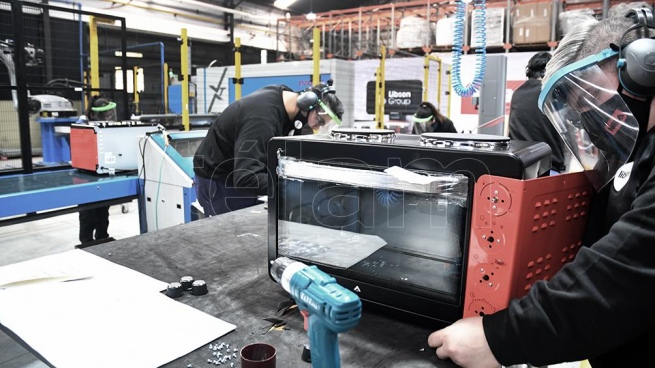The Manufacturing Industrial Production Index rose 3.6% during March in relation to the same month last year, while the Synthetic Indicator of Construction Activity (ISAC) advanced 1.9% in the same period, reported this Thursday the National Institute of Statistics and Censuses (Indec).
With these improvements, the manufacturing sector accumulated a rise of 3.7% in the first quarter of the year, and construction marked an increase of 1.3%. while in the comparison with the previous month -February-, the industry during March showed a drop of 1.9% and construction a decrease of 4.1%, specified the official agency.
“We closed the best first industrial quarter in 4 years: industrial production was not only better than 2020 and 2021, but also 9.8% higher than 2019”stated after the Indec figures were released, the Minister of Productive Development, Matías Kulfas, through his Twitter account.
The minister stressed that the Argentina has been “recovering formal industrial employment for 21 consecutive months. Today there are 67,000 more formal industrial jobs” that when the current government arrived, to which he asked “Do not forget: in 46 of the 48 months of the (Mauricio) Macri government, industrial employment was destroyed.”
#DatoINDEC
The industry grew 3.6% year-on-year in March 2022 and fell 1.9% compared to the previous month https://t.co/ixgQkYubUq pic.twitter.com/LlrcjrJEsu— INDEC Argentina (@INDECArgentina) May 5, 2022
The Ministry of Economy highlighted that the indicator of industrial activity prepared by the Indec grew somewhat below the 8.7% registered in February, and formed the second rise after falling 0.9% in January, when it showed the first retraction after 14 rising months.
Thus, the level of March in the year-on-year comparison, the manufacturing sector was 8.6% above the pre-covid level of February 2020, 15.4% above that of March 2019, and at levels similar to those of March of 2017 and 2018.
Among the reasons for the better performance was the increase in circulation, work and school presence, and the greater holding of events, based on fewer sanitary restrictions, as in the cases related to clothing, editing and printing, and production. of some food items, among others
By sector, in March 12 of the 16 sectors grew year-on-year. The largest were registered in “Other transport equipment”, with 46.9%; Garments, leather and footwear, 27.3%, which provided the maximum contribution of the month with 1.2 percentage points; and Tobacco, with 2.2%.
#DatoINDEC
Construction rose 1.9% year-on-year in March 2022 and fell 4.1% from the previous month https://t.co/67bx9K6eoY pic.twitter.com/hv3OTlAIta— INDEC Argentina (@INDECArgentina) May 5, 2022
The increases in the Wood, paper, publishing and printing categories were also highlighted, with an advance of 7.2%: Machinery and equipment, 5.9%; Chemicals, 4.1%; and Food and beverages, with an increase of 1.6%.
On the other hand, the items “Other equipment, devices and instruments” registered decreases, with 6.2%; Furniture and mattresses, 3.9%; Oil refining, 2.8%; and non-metallic minerals, 0.6%.
The Indec also revealed the expectations of businessmen about how they expect internal demand to evolve until June, including 36.5% of those consulted who assured that it will continue to increase, against 16% who anticipated a decrease and 47.5% who did not. anticipate further changes.
As for the exports26.6% of those consulted by the Indec estimated that they will increase against 17.2% who foresee a decrease, while 56.2% did not anticipate major variants.
As for the construction sector, the increase of 1.9% in March was accompanied by an increase in eight of the 13 inputs surveyed.
“Construction employment also recovers with 40,000 more formal jobs than before the pandemic”Matias Kulfas
Kulfas highlighted in this regard that “construction also crowned the best first quarter of the last 4 years. The activity of the sector was 3.9% higher than that of the first quarter of 2019”, while “construction employment also recovers with 40,000 more formal jobs than before the pandemic”.
The shipments of “Rest” led the growth, which includes seamless tubes, glass and taps, with an increase of 36.2% year-on-year; asphalt, 26.5%; and Plasterboard, 10.9%.
On the other hand, the inputs with the greatest falls were Bricks, 9.9% year-on-year; Mosaics, 5.1%, and Paintings, 4.6%, inputs more associated with small works or repairs.
about the next quarter
Regarding the expectations for the quarter that closes in June, among the businessmen who dedicate themselves primarily to private works, 34.5% estimated that it will continue to increase, against 6.9% who foresee a reduction and 58, 6% that there will be no major inconveniences.
Meanwhile, among those who mostly carry out public works, 32.9% anticipate a rise in the level of performance, 11.4% a decrease, and 55.7% do not envision major changes.
Regarding the type of works that will be carried out in the next three months, the companies that are mainly dedicated to private works distributed their responses as follows: housing, 18.2%; other works of architecture, 11.8%; road works and paving, 10.9%; industrial assemblies, 9.8%; gas infrastructure, 8.5%; industrial buildings, 8.3%; and distribution of water and sewage, 8.1%; among other.










